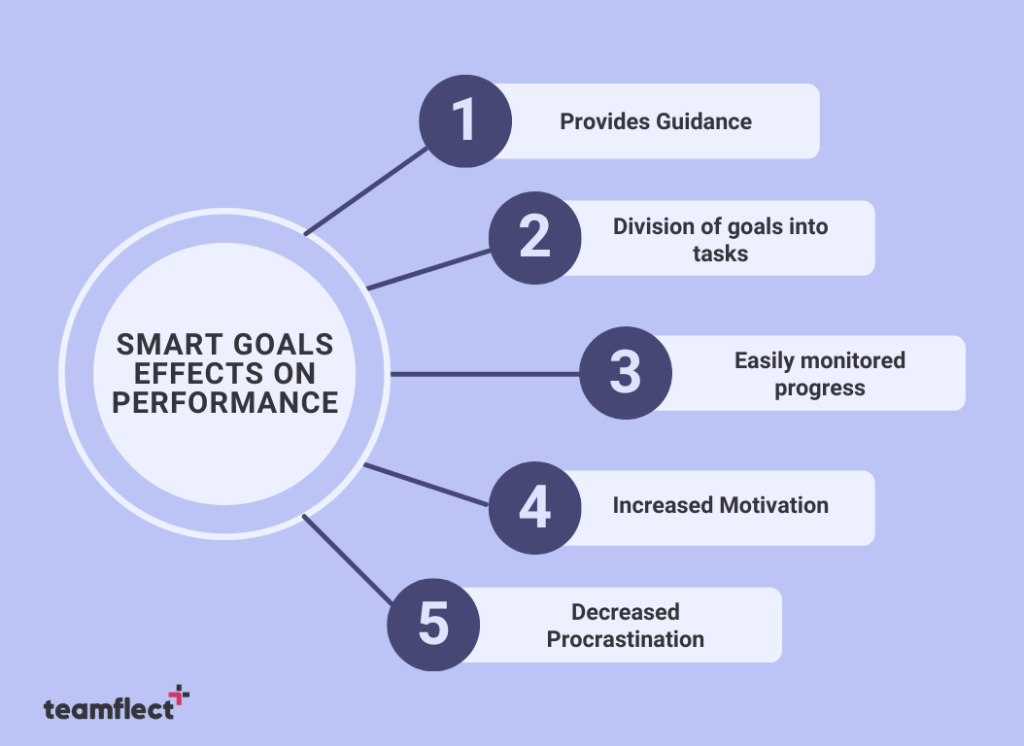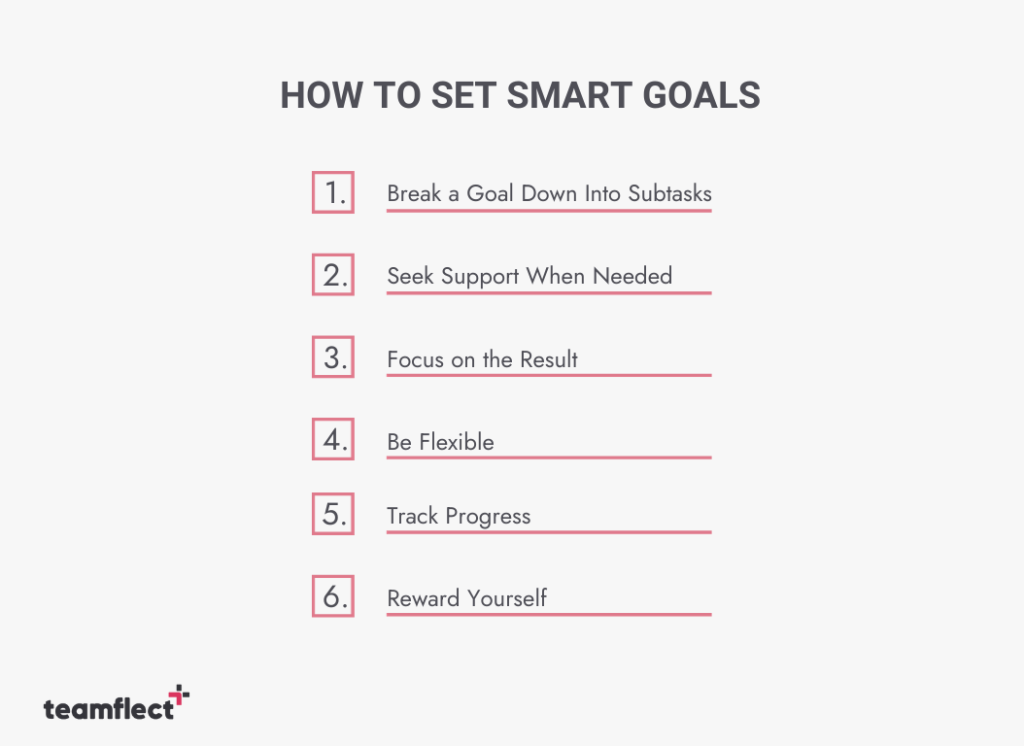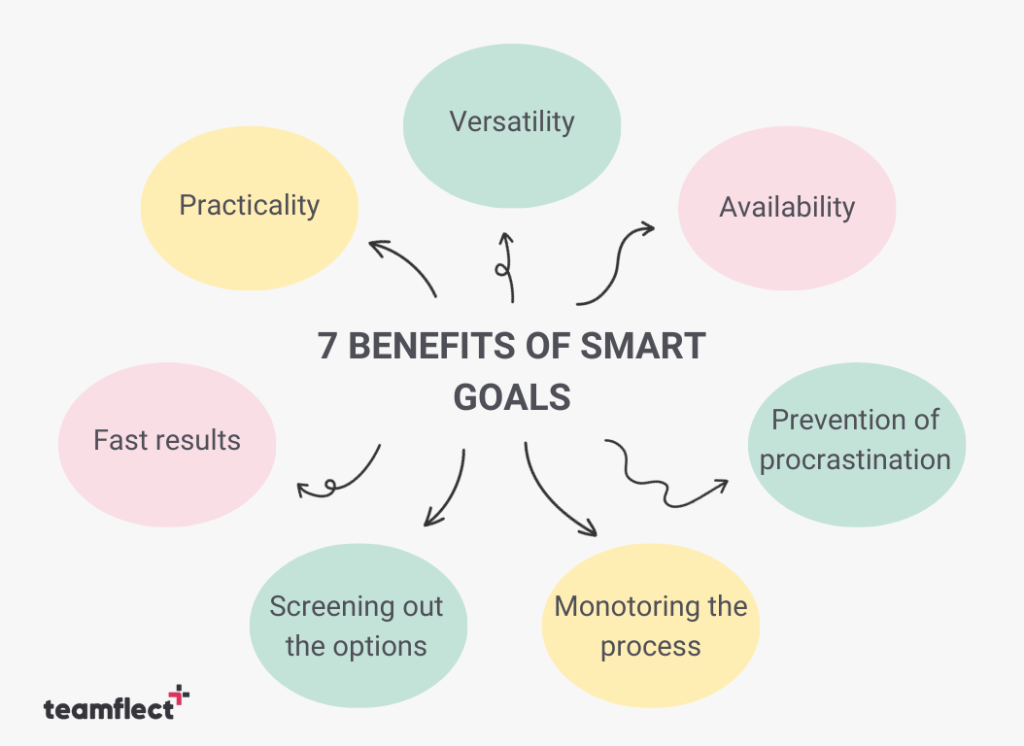Setting SMART goals is a modern method for creating work-related goals. SMART goal-setting theory determines the sufficiency of resources and provides all participants with straightforward, precise, specific tasks.
In this article, we will discuss why it’s important to set professional SMART goals and how you can set SMART goals.
Table of Contents
What are SMART goals?
Here is what the abbreviation SMART stands for: Specific, Measurable, Achievable, Relevant, Time-bound. This structure provides a better vision and understanding of the result, making it easier to manage the implementation process and achieve the goal. Let’s consider each smart goal in more detail.
Specific
The concept of “Specific” means that the result you want to achieve is precisely defined.
Measurable
The SMART goals should be measurable. Therefore, while setting goals, it is necessary to establish specific benchmarks for measuring the process of accomplishing the goal.
Achievable or Attainable
One should always set goals that are realistic and achievable to increase the motivation of the performer. Some of the constraints can include time, investments, labor resources, knowledge and experience of the executor, and the ability to make decisions.
Relevant
While determining the significance of a goal, it is essential to understand what contribution a specific task will make. To help you set goals that are truly meaningful, you should ask yourself the following question: What benefits will the company bring from performing the task?
Sometimes “Relevant” is also replaced by “Realistic”.
Time-bound
Time-bound means you need to create a schedule with a deadline or set how long the implementation of the SMART goals can take. When you establish a timeframe, it is easier to control whether you have enough time throughout the entire process so as not to miss any deadlines to reach your goals.
How do SMART goals affect performance?

Goal setting using the SMART goals method has a positive effect. Here is why such goal-setting is important:
- The preparation of the SMART goals guides you until you reach your goals.
- Setting SMART goals will help you divide bigger tasks into several small subtasks.
- During the implementation of the project, progress is easily monitored.
- SMART goals motivate, inspire, and reduce the risk of procrastination.
How to set SMART goals?
When you’re ready to set SMART goals, first formulate the final goal you want to reach. Then, match your goal against all five SMART attributes and make sure you’ve considered what is needed.

The most useful SMART goal-setting tips include:
1. Break a goal down into subtasks: The first step in how to set smart goals is breaking a goal down into smaller tasks. This way you can transform your broader and overwhelming goals into more digestible and actionable steps. This method will also provide you with a roadmap that can guide you throughout the process. You will be able to stay focused and motivated when you dissect the overall goal into smaller stages.
2. Seek Support when needed: Being open to receiving support when it comes to goal setting and implementation will allow you to make adjustments when necessary. By receiving feedback and collaborating with your team members, you can achieve your goals more easily.
3. Focus on the Result: When you focus on the result, you can have a more clear vision that drives you toward success. By frequently revisiting your ultimate goals, you can stay motivated and on track.
4. Flexible: Being flexible throughout the SMART goal-setting process will help you adapt more easily to changing circumstances. When you are open to different pathways to reach your goal you can adjust your strategies more effectively when needed. With an adaptable mindset, you will easily navigate through setbacks and stay committed to achieving your goals.
5. Track Progress: When you monitor your progress against specific milestones, you stay more organized and aware of your accomplishments. Being aware of your accomplishments will boost your confidence.
6. Reward Yourself: Creating smart goals is not an easy process and it may include setbacks. So, you need to have a positive mindset while working toward your objectives. To remain positive throughout the SMART goal-setting process you can reward yourself. These rewards should be meaningful and should be able to reinforce dedication to your goals. This is a vital step in making sure you make the smart goal-setting process effective and sustainable.
Keep these tips in mind when you’re creating smart goals for yourself to ensure you get the maximum amount of benefits from the objectives you’ve set. Now that we’ve covered the answer to “How to create smart goals?”, let’s move on to answering “What are the benefits of setting smart goals?”.
What Are the Benefits of SMART Goals?

There are various benefits to smart goal setting that will make you want to make this a sustainable practice in your day-to-day life. Creating smart goals will unquestionably bring you the following benefits:
- Practicality: It is easy to draw up an action plan due to its precise formulation.
- Versatility: The method is suitable for business planning, solving personal problems, and self-improvement.
- Availability: No special knowledge is required to set SMART goals.
- Fast results: Owing to the structured planning, the goals formulated using this method are achieved faster.
- Prevention of procrastination: Owing to the quantitative indicators and deadlines, SMART goals prevent procrastination.
- Monitoring the process: Quantitative indicators and decomposition help you monitor the entire process effectively.
- Screening out the options: Checking for achievability and relevance prevents employees from setting unachievable goals and wasting time on them.
Examples of SMART goals
Marketing:
- Specific: Increase brand awareness by launching a content marketing campaign.
- Measurable: Achieve a 20% increase in website traffic and a 15% growth in social media followers within six months.
- Achievable: Allocate a budget for content creation and hire additional content writers if needed.
- Relevant: Enhance brand visibility to align with the overall marketing strategy.
- Time-bound: Complete the campaign and assess results by the end of the next quarter.
Sales:
- Specific: Boost monthly sales revenue by expanding the customer base.
- Measurable: Achieve a 10% increase in monthly sales within the next fiscal year.
- Achievable: Train the sales team in new sales techniques and extend the product line.
- Relevant: Contribute to the company’s overall revenue growth.
- Time-bound: Monitor progress monthly and reach the goal by the end of the fiscal year.
Human Resources:
- Specific: Reduce employee turnover by enhancing the onboarding process.
- Measurable: Achieve a 15% reduction in employee turnover within the next year.
- Achievable: Revise the onboarding program, implement regular feedback sessions, and improve the company’s work culture.
- Relevant: Improve employee satisfaction and engagement.
- Time-bound: Assess turnover rates quarterly and achieve the goal within a year.
Non-profit organization goal:
- Specific: Expand the reach of our educational programs to underserved communities.
- Measurable: Establish partnerships with two local schools and serve 500 additional students within the next academic year.
- Achievable: Secure funding through grant applications and volunteer recruitment.
- Relevant: Fulfill the organization’s mission of providing educational opportunities to disadvantaged youth.
- Time-bound: Implement the program and measure the impact within one academic year.
SMART goals can help your team succeed by bringing clarity to goal-setting and project management processes. When your team clearly understands what to strive for, and moves in one direction, the motivation of employees grows, and they know what works to prioritize.
Fast Goals vs. Smart Goals
Both fast goals and smart goals aim to reach a similar outcome. However, they both have characteristics specific to them when doing so. Let’s briefly break down the two so you can spot the difference a little more easily.
Fast Goals:
Fast goal setting usually has a broader focus and as its name suggests as well, it aims for fast results more so than a structured and strategic plan that can assist you in a longer period of time.
You may characterize fast goals as:
- Often impulsive
- Reactive
- Lacks specificity and definition
- Highlights quick action
- Not much consideration for long-term effects
SMART Goals
Smart goal setting on the other hand provides structure and an approach that is strategically planned for long-term success, compared to fast goals.
Its characteristics can be identified from the acronym itself:
- Specific
- Measurable
- Achievable
- Relevant
- Time-bound
All in all, fast goals are often an impulsive act towards a goal that you can immediately achieve or visualize. Smart goal setting in this sense would be a much better suit if you’re seeking a detailed and trackable road map to reaching your objectives.
Closing Words
We answered the question, “How to create smart goals?” and provided you with smart goal-setting tips to streamline your goal implementation processes.
To level up your goal-setting process, you can also use Teamflect as performance management software. Teamflect will facilitate your goal implementation with its user-friendly interface and strong integration with Microsoft Teams.
And the best part is you can use Teamflect completely free with full functionality for up to 10 users!



